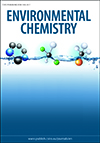Dr Jing Ming (Beacon Science & Consulting)
Dr Andrea Spolaor (Italian National Research Council)

Environmental Chemistry
Volume 19 Number 5 2022
RESEARCH FRONT: The Chemistry of Terrestrial Cold Environments
 , Beatrice Moroni, Chiara Petroselli
, Beatrice Moroni, Chiara Petroselli  , Paola Gravina, Roberta Selvaggi, Massimo Pecci, Andrea Spolaor, Paolo Tuccella, Edoardo Raparelli, Jacopo Gabrieli, Giulio Esposito, Pinuccio D’Aquila and David Cappelletti
, Paola Gravina, Roberta Selvaggi, Massimo Pecci, Andrea Spolaor, Paolo Tuccella, Edoardo Raparelli, Jacopo Gabrieli, Giulio Esposito, Pinuccio D’Aquila and David Cappelletti
Environmental context. We present a chemical characterisation of the seasonal snowpack sampled for four consecutive years at the Calderone, the southernmost glacier still surviving in peninsular Italy. This debris covered glacier recently split into two little ice bodies, whose evolution could be influenced by the snowpack properties. In particular the impact of long-range aerosol advections on concentrations of impurities in the snowpack over the local background is discussed.
Environmental context. Snow albedo plays an important role in the Earth environment. Light-absorbing particles (LAPs) can significantly impact snow albedo through complex interactions and feedbacks over the global cryosphere. This study provides a unique review of the fundamentals, recent advances, challenges and future research directions in modelling LAP–snow–radiation interactions and impacts on snow albedo.
EN22013 Abstract | EN22013 Full Text | EN22013PDF (3.7 MB) Open Access Article
 , Imtiyaz Ahmad Bhat, Nadeem Ahmad Najar, Shichang Kang, Faisal Zahoor Jan, Shahid Ahmad Dar
, Imtiyaz Ahmad Bhat, Nadeem Ahmad Najar, Shichang Kang, Faisal Zahoor Jan, Shahid Ahmad Dar  , Sami Ullah Bhat, Syed Danish Rafiq Kashani and Waseem Rasool
, Sami Ullah Bhat, Syed Danish Rafiq Kashani and Waseem Rasool
Environmental context. While it is known that aerosol deposition causes exacerbated melt of the glaciers, information about aerosol variability and deposition in the glaciated environments in the western Himalayas is still lacking. We analysed the aerosol variability, modelled the potential aerosol sources and assessed physicochemical characteristics of glacier ice in the region. This information could be foundational for initiating studies on aerosol impacts on the glacier melt besides climate change.
Environmental context. One-year-long on-line measurements of surface O3 and CO mixing ratios were performed on the southeast Tibetan Plateau to examine O3 behaviour. During the daytime, the O3 mixing ratio was strongly affected by vertical air exchange. The O3 mixing ratio was high in the afternoon and decreased at night, indicating a sink of tropospheric O3. The upper limit of the tropospheric O3 sink averaged from 4.5 to 5.5 ppb h−1.